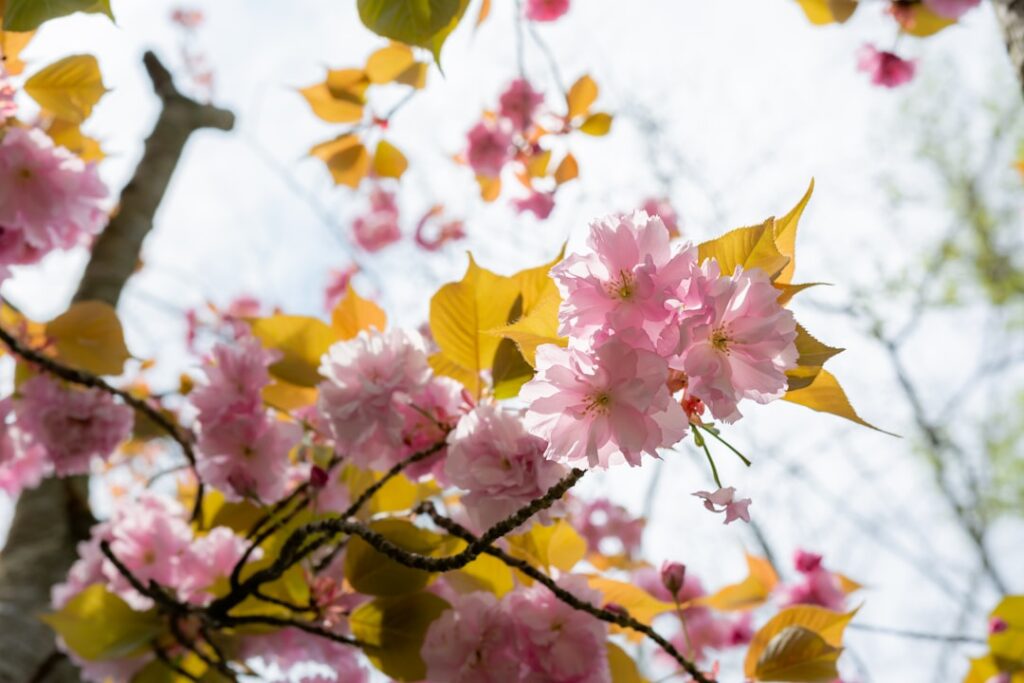Crape Myrtle trees, also known as Lagerstroemia, are popular ornamental trees that are prized for their vibrant and long-lasting summer blooms. These trees are native to Asia and are widely cultivated in the United States for their beautiful flowers, attractive bark, and resistance to drought and pests. Crape Myrtle trees are available in a variety of sizes, from small shrubs to large trees, making them versatile for different landscape settings. They are also known for their stunning fall foliage, which adds another layer of interest to the landscape. With their low maintenance requirements and ability to thrive in a wide range of climates, Crape Myrtle trees have become a favorite choice for homeowners and landscapers alike.
Crape Myrtle trees are known for their showy clusters of flowers that bloom in the summer months, ranging in color from white and pink to red and purple. These flowers can last for several weeks, adding a burst of color to the landscape during the hottest months of the year. In addition to their beautiful blooms, Crape Myrtle trees also have attractive bark that peels to reveal a smooth, mottled surface in shades of gray, brown, and cinnamon. This unique feature adds visual interest to the tree, especially during the winter months when the branches are bare. With their multi-seasonal appeal and adaptability to various growing conditions, Crape Myrtle trees have become a popular choice for adding beauty and interest to residential and commercial landscapes.
Key Takeaways
- Crape Myrtle trees are popular for their vibrant flowers and attractive bark, making them a great addition to any landscape.
- When choosing a variety, consider factors such as size, flower color, and disease resistance to ensure the right fit for your landscape.
- Proper planting and care, including well-drained soil and regular watering, are essential for the health and growth of Crape Myrtle trees.
- Pruning in late winter or early spring and removing suckers can help maintain the shape and promote flowering of Crape Myrtle trees.
- Keep an eye out for common pests and diseases such as aphids, powdery mildew, and Crape Myrtle bark scale, and take preventive measures to protect your trees.
Choosing the Right Variety for Your Landscape
When it comes to choosing the right Crape Myrtle variety for your landscape, there are several factors to consider, including size, flower color, and cold hardiness. Crape Myrtle trees come in a wide range of sizes, from dwarf shrubs that reach only a few feet tall to large trees that can grow up to 30 feet in height. It’s important to consider the available space in your landscape and choose a variety that will fit the scale of your garden or outdoor area. Additionally, Crape Myrtle trees are available in a variety of flower colors, including white, pink, red, and purple. Consider the color scheme of your landscape and choose a variety that will complement the existing plants and hardscape elements.
Another important consideration when choosing a Crape Myrtle variety is cold hardiness. While Crape Myrtle trees are generally tolerant of a wide range of climates, some varieties are more cold hardy than others. If you live in a region with harsh winters, it’s important to select a variety that is well-suited to your climate to ensure its long-term survival and success in your landscape. Additionally, consider the overall growth habit of the tree, including its shape and form, as well as any special features such as fall foliage color or bark texture. By carefully considering these factors, you can choose the right Crape Myrtle variety that will thrive in your landscape and provide years of beauty and enjoyment.
Planting and Caring for Crape Myrtle Trees
Planting and caring for Crape Myrtle trees is relatively easy, making them an ideal choice for both novice and experienced gardeners. When planting a Crape Myrtle tree, it’s important to select a location that receives full sun for optimal flowering and growth. These trees prefer well-drained soil and will benefit from regular watering during their establishment period. When planting a new Crape Myrtle tree, be sure to dig a hole that is at least twice as wide as the root ball and at the same depth. Gently loosen the roots before placing the tree in the hole and backfill with soil, tamping it down gently to remove any air pockets.
Once planted, Crape Myrtle trees require minimal care to thrive in the landscape. Regular watering is important during the first year after planting to help the tree establish a strong root system. After the first year, Crape Myrtle trees are relatively drought-tolerant and will only require supplemental watering during periods of prolonged dryness. Fertilizing is generally not necessary for established Crape Myrtle trees unless they show signs of nutrient deficiencies such as yellowing leaves or poor growth. In terms of pruning, Crape Myrtle trees benefit from light annual pruning to remove any dead or crossing branches and promote a healthy growth habit. With proper planting and minimal care, Crape Myrtle trees can thrive in a variety of landscape settings and provide years of beauty and enjoyment.
Pruning and Maintenance Tips
| Pruning and Maintenance Tips |
|---|
| 1. Regularly inspect plants for signs of disease or pest infestation. |
| 2. Prune dead or damaged branches to promote healthy growth. |
| 3. Use clean, sharp tools to make clean cuts and prevent disease spread. |
| 4. Research the specific pruning needs of each plant species for best results. |
| 5. Remove any suckers or water sprouts to maintain plant shape and health. |
Pruning is an important aspect of caring for Crape Myrtle trees, as it helps maintain their shape, promote healthy growth, and encourage abundant flowering. When pruning Crape Myrtle trees, it’s important to avoid common mistakes such as “topping,” which involves cutting back the branches to stubs. This practice not only ruins the natural form of the tree but also leads to weak growth and an overabundance of new shoots that can detract from the overall appearance of the tree. Instead, focus on removing any dead or crossing branches, as well as any suckers that emerge from the base of the tree. This will help maintain an open canopy and promote good air circulation throughout the tree.
In addition to pruning, regular maintenance tasks such as mulching and fertilizing can help keep Crape Myrtle trees healthy and vibrant. Mulching around the base of the tree helps retain moisture in the soil, suppresses weeds, and insulates the roots from temperature extremes. When applying mulch, be sure to spread it evenly around the base of the tree, leaving a few inches of space between the mulch and the trunk to prevent moisture-related issues such as rot or disease. Fertilizing is generally not necessary for established Crape Myrtle trees unless they show signs of nutrient deficiencies. If fertilization is needed, choose a balanced fertilizer formulated for flowering trees and follow the manufacturer’s recommendations for application rates and timing. By following these pruning and maintenance tips, you can help ensure that your Crape Myrtle trees remain healthy and beautiful for years to come.
Common Pests and Diseases to Watch Out For
While Crape Myrtle trees are generally resistant to pests and diseases, there are a few common issues that gardeners should be aware of when caring for these trees. One of the most common pests that can affect Crape Myrtle trees is aphids, which are small insects that feed on the sap of new growth and can cause leaves to become distorted or covered in sticky honeydew. To control aphids, consider using natural predators such as ladybugs or lacewings or spraying the affected foliage with a strong stream of water to dislodge the insects. Another potential pest is powdery mildew, a fungal disease that can cause a white powdery coating to develop on the leaves of Crape Myrtle trees. To prevent powdery mildew, ensure that your Crape Myrtle trees are planted in a location with good air circulation and avoid overhead watering.
In addition to pests and diseases, Crape Myrtle trees can also be susceptible to environmental stressors such as drought or extreme temperatures. To help mitigate these issues, be sure to provide regular watering during dry periods and consider mulching around the base of the tree to help retain soil moisture. Additionally, avoid planting Crape Myrtle trees in areas with poor drainage or compacted soil, as this can lead to root rot or other issues related to waterlogged conditions. By monitoring your Crape Myrtle trees for signs of pests, diseases, or environmental stressors and taking proactive measures to address these issues, you can help ensure that your trees remain healthy and vibrant in the landscape.
Using Crape Myrtle Trees in Landscape Design

Crape Myrtle trees are incredibly versatile plants that can be used in a variety of landscape design applications to add beauty, interest, and structure to outdoor spaces. These trees are well-suited for use as specimen plants in garden beds or as focal points in mixed borders where their colorful blooms can take center stage. Additionally, Crape Myrtle trees can be used as informal hedges or screens to provide privacy or define outdoor living areas. Their multi-seasonal appeal makes them an ideal choice for adding visual interest throughout the year, from their vibrant summer blooms to their stunning fall foliage and attractive winter bark.
In addition to their ornamental value, Crape Myrtle trees can also be used in urban landscapes to provide shade, reduce noise pollution, and improve air quality. Their relatively small size makes them well-suited for planting along streetscapes or in parking lots where space may be limited. Additionally, their tolerance of urban conditions such as pollution and compacted soil makes them an ideal choice for adding greenery to city environments. Whether used as a focal point in a residential garden or as a functional element in an urban setting, Crape Myrtle trees offer numerous opportunities for enhancing landscape design and creating beautiful outdoor spaces.
Benefits of Adding Crape Myrtle Trees to Your Landscape
There are numerous benefits to adding Crape Myrtle trees to your landscape, from their beautiful blooms and attractive bark to their low maintenance requirements and adaptability to various growing conditions. These trees provide long-lasting summer color with their showy clusters of flowers that can last for several weeks, adding vibrancy and interest to the landscape during the hottest months of the year. Additionally, their stunning fall foliage adds another layer of beauty to the landscape as the leaves change color before dropping in preparation for winter.
In addition to their ornamental value, Crape Myrtle trees offer practical benefits such as drought tolerance and resistance to pests and diseases. This makes them an ideal choice for homeowners who want to add beauty to their landscape without having to invest a lot of time or effort into maintenance. Furthermore, their adaptability to various growing conditions makes them well-suited for a wide range of climates and soil types, allowing them to thrive in diverse landscapes across the country. By adding Crape Myrtle trees to your landscape, you can enjoy their beauty year after year while reaping the practical benefits of their low maintenance requirements and resilience in challenging growing conditions.
In conclusion, Crape Myrtle trees are versatile ornamental plants that offer numerous benefits for homeowners and landscapers alike. With their vibrant summer blooms, attractive bark, low maintenance requirements, and adaptability to various growing conditions, these trees have become a popular choice for adding beauty and interest to residential and commercial landscapes. By carefully selecting the right variety for your landscape, planting and caring for your Crape Myrtle trees properly, addressing common pests and diseases, using them effectively in landscape design applications, and enjoying their numerous benefits year after year, you can enhance your outdoor spaces with these stunning ornamental trees. Whether used as focal points in garden beds or functional elements in urban environments, Crape Myrtle trees offer endless opportunities for creating beautiful outdoor spaces that can be enjoyed throughout the year.
Looking to learn more about crape myrtle trees? Check out this informative article on crape myrtle tree care and maintenance from Magic Star Media. Whether you’re a seasoned gardener or just starting out, this article provides valuable insights and tips for keeping your crape myrtle tree healthy and thriving. From pruning to pest control, this resource covers it all. For more in-depth information, be sure to visit Magic Star Media.
FAQs
What is a crape myrtle tree?
A crape myrtle tree is a deciduous flowering tree that is known for its vibrant and long-lasting blooms. It is a popular choice for landscaping due to its beautiful flowers and attractive bark.
How big do crape myrtle trees grow?
Crape myrtle trees can vary in size depending on the variety, but they typically range from 10 to 30 feet in height and 6 to 15 feet in width.
What are the different flower colors of crape myrtle trees?
Crape myrtle trees produce flowers in a wide range of colors, including white, pink, red, and purple. Some varieties also have multi-colored blooms.
When do crape myrtle trees bloom?
Crape myrtle trees typically bloom in the summer, from late June to early September, depending on the variety and climate.
How do I care for a crape myrtle tree?
Crape myrtle trees prefer full sun and well-drained soil. They should be watered regularly, especially during dry periods, and pruned in late winter or early spring to promote healthy growth and flowering.
Are crape myrtle trees drought-tolerant?
Crape myrtle trees are relatively drought-tolerant once established, but they will benefit from regular watering, especially during hot and dry periods.
Can crape myrtle trees be grown in containers?
Crape myrtle trees can be grown in containers, but they will require regular watering and may need to be repotted as they grow. It’s important to choose a large enough container to accommodate the tree’s root system.





